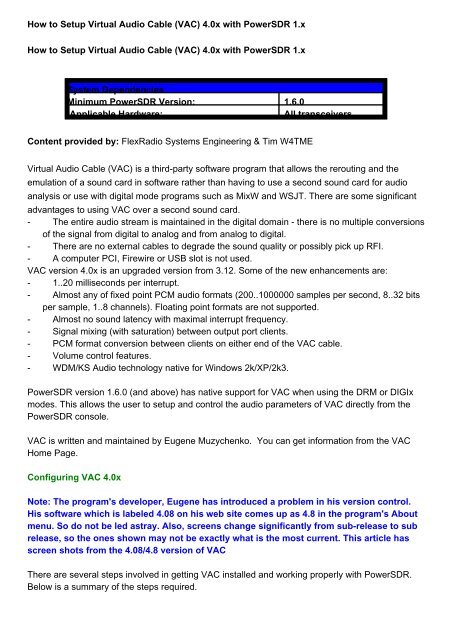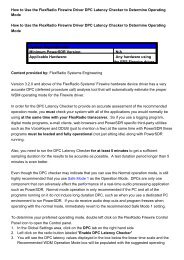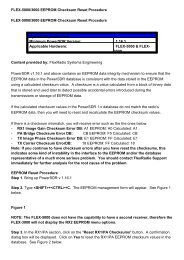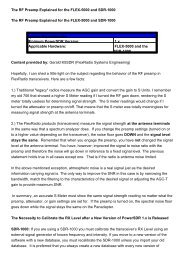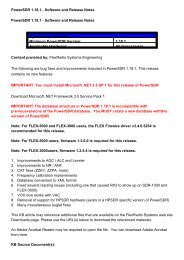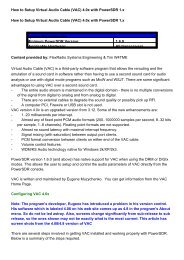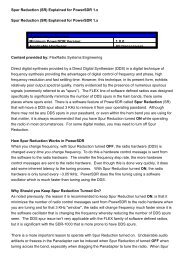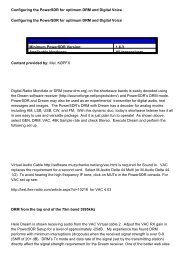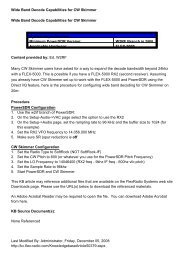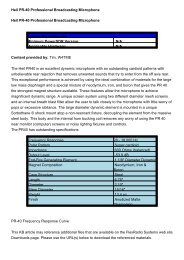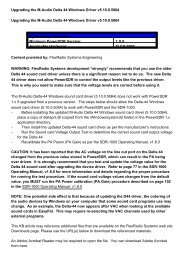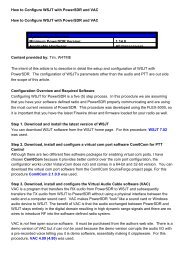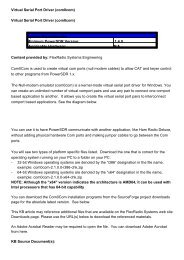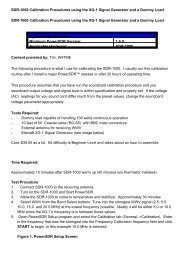How to Setup Virtual Audio Cable (VAC) 4.0x with PowerSDR 1.x ...
How to Setup Virtual Audio Cable (VAC) 4.0x with PowerSDR 1.x ...
How to Setup Virtual Audio Cable (VAC) 4.0x with PowerSDR 1.x ...
Create successful ePaper yourself
Turn your PDF publications into a flip-book with our unique Google optimized e-Paper software.
<strong>How</strong> <strong>to</strong> <strong>Setup</strong> <strong>Virtual</strong> <strong>Audio</strong> <strong>Cable</strong> (<strong>VAC</strong>) <strong>4.0x</strong> <strong>with</strong> <strong>PowerSDR</strong> <strong>1.x</strong><br />
<strong>How</strong> <strong>to</strong> <strong>Setup</strong> <strong>Virtual</strong> <strong>Audio</strong> <strong>Cable</strong> (<strong>VAC</strong>) <strong>4.0x</strong> <strong>with</strong> <strong>PowerSDR</strong> <strong>1.x</strong><br />
System Dependencies<br />
Minimum <strong>PowerSDR</strong> Version: 1.6.0<br />
Applicable Hardware:<br />
All transceivers<br />
Content provided by: FlexRadio Systems Engineering & Tim W4TME<br />
<strong>Virtual</strong> <strong>Audio</strong> <strong>Cable</strong> (<strong>VAC</strong>) is a third-party software program that allows the rerouting and the<br />
emulation of a sound card in software rather than having <strong>to</strong> use a second sound card for audio<br />
analysis or use <strong>with</strong> digital mode programs such as MixW and WSJT. There are some significant<br />
advantages <strong>to</strong> using <strong>VAC</strong> over a second sound card.<br />
- The entire audio stream is maintained in the digital domain - there is no multiple conversions<br />
of the signal from digital <strong>to</strong> analog and from analog <strong>to</strong> digital.<br />
- There are no external cables <strong>to</strong> degrade the sound quality or possibly pick up RFI.<br />
- A computer PCI, Firewire or USB slot is not used.<br />
<strong>VAC</strong> version <strong>4.0x</strong> is an upgraded version from 3.12. Some of the new enhancements are:<br />
-<br />
-<br />
-<br />
-<br />
-<br />
-<br />
-<br />
1..20 milliseconds per interrupt.<br />
Almost any of fixed point PCM audio formats (200..1000000 samples per second, 8..32 bits<br />
per sample, 1..8 channels). Floating point formats are not supported.<br />
Almost no sound latency <strong>with</strong> maximal interrupt frequency.<br />
Signal mixing (<strong>with</strong> saturation) between output port clients.<br />
PCM format conversion between clients on either end of the <strong>VAC</strong> cable.<br />
Volume control features.<br />
WDM/KS <strong>Audio</strong> technology native for Windows 2k/XP/2k3.<br />
<strong>PowerSDR</strong> version 1.6.0 (and above) has native support for <strong>VAC</strong> when using the DRM or DIGIx<br />
modes. This allows the user <strong>to</strong> setup and control the audio parameters of <strong>VAC</strong> directly from the<br />
<strong>PowerSDR</strong> console.<br />
<strong>VAC</strong> is written and maintained by Eugene Muzychenko. You can get information from the <strong>VAC</strong><br />
Home Page.<br />
Configuring <strong>VAC</strong> <strong>4.0x</strong><br />
Note: The program's developer, Eugene has introduced a problem in his version control.<br />
His software which is labeled 4.08 on his web site comes up as 4.8 in the program's About<br />
menu. So do not be led astray. Also, screens change significantly from sub-release <strong>to</strong> sub<br />
release, so the ones shown may not be exactly what is the most current. This article has<br />
screen shots from the 4.08/4.8 version of <strong>VAC</strong><br />
There are several steps involved in getting <strong>VAC</strong> installed and working properly <strong>with</strong> <strong>PowerSDR</strong>.<br />
Below is a summary of the steps required.
1. Obtain and install <strong>VAC</strong> <strong>4.0x</strong> on the same computer that is running <strong>PowerSDR</strong><br />
2. Configure <strong>VAC</strong> "cables"<br />
3. Configure <strong>PowerSDR</strong> <strong>to</strong> utilize <strong>VAC</strong><br />
Step 1. Install <strong>VAC</strong> <strong>4.0x</strong> as per the installation directions. If <strong>VAC</strong> was previously loaded, you must<br />
first uninstall all versions before installing a new version of <strong>VAC</strong> <strong>4.0x</strong><br />
Step 2. Once installed, set up a pair of <strong>VAC</strong> audio "cables" for use <strong>with</strong> <strong>PowerSDR</strong> by opening the<br />
<strong>VAC</strong> Control Panel.<br />
Figure 1 - <strong>VAC</strong> Console<br />
Step 3. By default only one audio cable is defined. You will need <strong>to</strong> create two cables by changing<br />
the driver parameters <strong>to</strong> 2 cables then click SET and Restart. Highlight the appropriate cable and<br />
change the values <strong>to</strong> match the figure above. In the "Ms per int" box enter a value between 1 and<br />
20 ms. The lower the value, the smaller the <strong>VAC</strong> audio buffer. In the example above, 7 ms was<br />
selected. Depending on your computer setup you may have <strong>to</strong> adjust this value <strong>to</strong> prevent the<br />
audio from dropping out or "popping".<br />
You can choose two different Stream limit formats; cable format and cable range. Since<br />
<strong>PowerSDR</strong> defines both audio cables' format when <strong>VAC</strong> support is enabled, using the <strong>Cable</strong><br />
Format is recommended. If you decide <strong>to</strong> use the <strong>Cable</strong> Range stream format, one thing <strong>to</strong><br />
consider, when a format conversion occurs, it takes significant CPU resources and it may<br />
noticeably slow your applications causing audio drops outs. Therefore using <strong>Cable</strong> Format as the<br />
stream format may help <strong>with</strong> audio drop outs. In the example above, I am using <strong>Cable</strong> Range<br />
because it provides the most flexibility and does not adversely affect the performance of<br />
<strong>PowerSDR</strong> on the computer I am using.<br />
After completing all of the necessary changes, click on Set for each cable when completed.<br />
NOTE: Repeat these changes for the second audio cable as well.<br />
NOTE: Do NOT check the Volume Control box in the <strong>VAC</strong> control panel. This enables the<br />
Windows Mixer and can cause unpredictable results.<br />
Step 4. Start up <strong>PowerSDR</strong> version 1.6.0 (or higher). Click <strong>Setup</strong> on the Menu Bar. The<br />
<strong>PowerSDR</strong> <strong>Setup</strong> program is displayed. See example below.<br />
Figure 2 - <strong>PowerSDR</strong> <strong>Setup</strong> (default page)<br />
Step 5. Click on the <strong>Audio</strong> tab and then click on the <strong>VAC</strong> tab.<br />
Figure 3 - <strong>VAC</strong> <strong>Setup</strong>
Step 6. In the "<strong>Virtual</strong> <strong>Audio</strong> <strong>Cable</strong> <strong>Setup</strong>" section, set the "Driver" <strong>to</strong> MME using the drop down<br />
box (other driver options, such as Windows WDM-KS are supported but may work depending on<br />
the sound card application being used. For this article, MME is used because it is the most<br />
compatible. Once you have <strong>VAC</strong> working, you can experiment <strong>with</strong> the other drivers. Their<br />
advantage is that they have less inherent latency for audio transfer). In the "Input" drop down box,<br />
select <strong>Virtual</strong> <strong>Cable</strong> 1. In the "Output" drop down box, select <strong>Virtual</strong> <strong>Cable</strong> 2. In the "Au<strong>to</strong><br />
Enable" section, select this option if you want <strong>VAC</strong> <strong>to</strong> au<strong>to</strong>matically engage when any of the digital<br />
modes (DIGIx or DRM) are selected on the <strong>PowerSDR</strong> console. This is the preferred setting. In<br />
the "Buffer Size" section, select a buffer size from the drop down box. Depending on your<br />
computer setup you may have <strong>to</strong> adjust this value <strong>to</strong> prevent the audio from dropping out or<br />
"popping". In the "Sample Rate" section, select a higher sampling rate from the drop down box<br />
option that exceeds the sampling rate of the sound card program you are using. Using a<br />
sampling rate of 48K provides the best audio quality and produces the fewest drop outs.<br />
Troubleshooting Technique: In some cases the sound card program can not handle format<br />
down conversion very well resulting in no or poor audio processing. If this is the case,<br />
change the Sample rate <strong>to</strong> exactly match that of the sound card program you are using.<br />
If the soundcard program uses a stereo mode, such as DReaM, then select the Stereo option in<br />
the "Mono/Stereo" section. And finally, the "Gain (dB)" section is the place where you adjust the<br />
AF gain of the <strong>VAC</strong> cable. Since the Volume Control was not checked on the <strong>VAC</strong> Control Panel<br />
(step #3) the Windows Mixer is not available for <strong>VAC</strong> cables. Use only the adjustments in<br />
<strong>PowerSDR</strong> <strong>to</strong> increase or decrease the volume (AF gain) going <strong>to</strong> and from the sound card<br />
application.<br />
NOTE: Always start <strong>PowerSDR</strong> <strong>with</strong> <strong>VAC</strong> enabled before starting the sound card program<br />
so that <strong>PowerSDR</strong> can define the <strong>VAC</strong> cable format<br />
Setp 7. To check <strong>to</strong> see if <strong>VAC</strong> is properly working, Select a digital mode in <strong>PowerSDR</strong> and make<br />
sure the radio is "On" and not in "Stand By" mode. The Open the <strong>VAC</strong> Control panel and you<br />
should see the audio cables active.<br />
Figure 4 - <strong>VAC</strong> Control Panel<br />
As displayed above, the <strong>VAC</strong> channels are active, but only for <strong>PowerSDR</strong>. If you look at <strong>Cable</strong> 1,<br />
you will see that the number of "Pb streams" is 0 (zero) and the "Rc streams" for <strong>Cable</strong> 2 is also 0.<br />
<strong>VAC</strong> <strong>4.0x</strong> au<strong>to</strong>matically sets up both ends of the audio cable even if the client (sound card)<br />
program is not configured or even running.<br />
Step 8. When setting up <strong>VAC</strong> <strong>with</strong> two audio programs, the audio output of one program uses the<br />
same audio cable as the input of the other. Conversely, the audio input of the first program uses<br />
the same audio cable as the output of the other.
In your sound card program's setup for which sound card you are using, you will need <strong>to</strong> set the<br />
sound card input <strong>to</strong> "<strong>Virtual</strong> <strong>Cable</strong> 2" and the output <strong>to</strong> "<strong>Virtual</strong> <strong>Cable</strong> 1". Below is an example of<br />
how MixW is configured. Note that the sampling rate does not match what was setup in<br />
<strong>PowerSDR</strong> - This asymmetric configuration seems <strong>to</strong> provide the best audio quality and the fewest<br />
audio drop outs.<br />
Figure 5 - MixW Sound Device Settings<br />
Step 9. After you have the sound card program's audio input and output set, you should start<br />
observing audio either by hearing it or watching it on a spectrum display such as a waterfall. You<br />
can verify the <strong>VAC</strong> channel for the client program is active by looking at the <strong>VAC</strong> control panel.<br />
Figure 6 - <strong>VAC</strong> Control Panel <strong>with</strong> MixW receiving<br />
Notice that the value in the RcStream for <strong>Cable</strong> 2 has changed for a 0 (zero) <strong>to</strong> a 1 (one). This<br />
indicates that cable 2, which is the input for MixW is actively receiving audio from <strong>PowerSDR</strong>.<br />
Note: The Pb Stream value for <strong>VAC</strong> audio cable 1 is still 0 (zero). This will not change <strong>to</strong> a<br />
one (1) until you are transmitting using the sound card program and MixW is sending audio<br />
through that cable.<br />
Figure 7 - <strong>VAC</strong> Control Panel <strong>with</strong> MixW Transmitting<br />
Step 10. At this point you have completed the set up of <strong>VAC</strong> <strong>4.0x</strong> <strong>with</strong> a sound card program.<br />
This KB article may reference additional files that are available on the FlexRadio Systems web site<br />
Downloads page. Please use the URL(s) below <strong>to</strong> download the referenced materials.<br />
An Adobe Acrobat Reader may be required <strong>to</strong> open the file. You can download Adobe Acrobat<br />
from here.<br />
KB Source Document(s):<br />
NoneReferenced<br />
Last Modified By: Administra<strong>to</strong>r, Sunday, Oc<strong>to</strong>ber 19, 2008<br />
http://kc.flex-radio.com/KnowledgebaseArticle50230.aspx<br />
Tuesday, September 22, 2009


